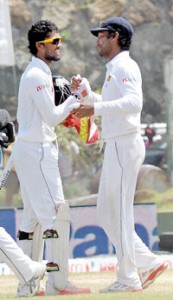Lankan cricket through the looking glass
The players are having a break and so are the coaches. Everything (though not hunky dory) seems calm on the surface. Or, is it?
In the post Mahela, Kumar era, Sri Lanka has some major issues to deal with. The techniques of a few batsmen have been called in question. Had we batted just that little better at the SSC, we could have won the Indian series.

Chandimal came up with good knocks in absence of Sangakkara
Angelo Mathews stands tall and should be above criticism, having cleared out three hundreds, a 77, a 62 and a 43 not out in the six tests.
supporting role has been conspicuous by its absence, Dinesh Chandimal struck an out-of-this-world unbeaten 162 at Galle. Apart from the 67 at Pallekele and the 59 that preceded his Magnum Opus, he didn’t turn on the runs expected of him.
Kaushal Silva (125, 80, 56 and 55) and Dimuth Karunaratne (79, 50, 139 and 46) were not involved in partnerships of substance. Ay! There’s the rub. Kumar Sangakkara, as is his wont, was unable to make light of these lapses and come up with the goods.
There were no salvage operations by the illustrious left hander. Lahiru Thirimanne, and the recalled Mubarak, were found wanting. The corridor of uncertainty was exploited, and Ajinkya Rahane at pounced on the nicks and nudges.
The Malaise goes deeper. It extends to the batsmen in waiting. The fringe players had twenty seven days of competitive cricket with their counterparts how South Africa, Afghanistan and Bengal. It was left to Niroshan Dickwella to make the only hundred – that, too, on the very last day.
Looking at the domestic scene, the situation batting-wise is slightly alarming. In the Premier Division, many teams are bowled out on day one of a three day match. Occupation of the crease, building long innings, wearing out the bowlers, all seem things of the past.
With a preponderance of clubs emphasis is laid on quantity at the expense of quality. Australia, New Zealand and South Africa, for example, have very few teams playing in the top tier. This makes for a better contested, tougher and more meaningful tournament where runs scored and wickets taken have more value.
Good batsmen are reared on good tracks, and this is where the standard of the pitches on which domestic cricket is played must needs be looked at. Test pitches don’t turn from day one and, at that level, the spinners have to do the hard yards. Not so the tracks used for club cricket which are low, slow and provide plenty of purchase.
As a result of team being bowled out early and cheaply, bowlers are not called upon to bowl more than 15 overs or 80 in the first innings. These workloads don’t reflect the demands of Test cricket where even a fast bowler may have to send down twenty overs or more in a day’s play.
Players with talent are plentiful, especially at the ages of 14, 15 and 16. It is what happens thereafter that causes concern.
Related to the Sachithra Senanayake, Tharindu Kaushal issues, comes the shocking news that 178 school and club bowlers have been reported by umpires. The offenders have been screened. High frame video cameras that enable the action to be slowed down have been used.
The finding is that, in most cases, the extension is far beyond that permitted, finally, a fact that is glossed over and swept under the carpet. At every Under-19 World Cup beginning 2006, a Sri Lankan bowler, or two, have been reported far a suspect action. Food for thought!


